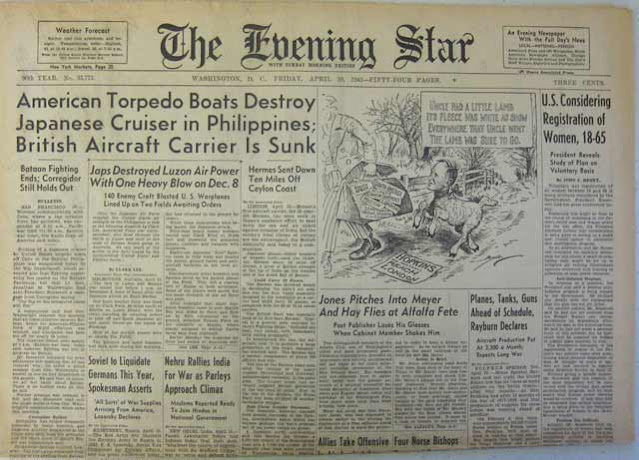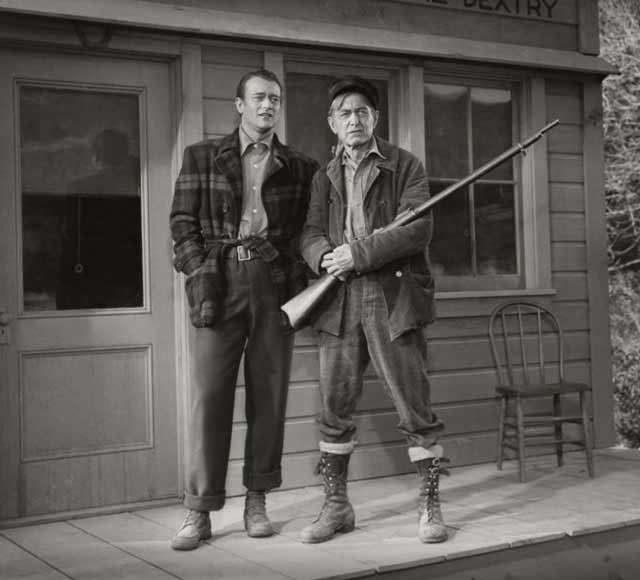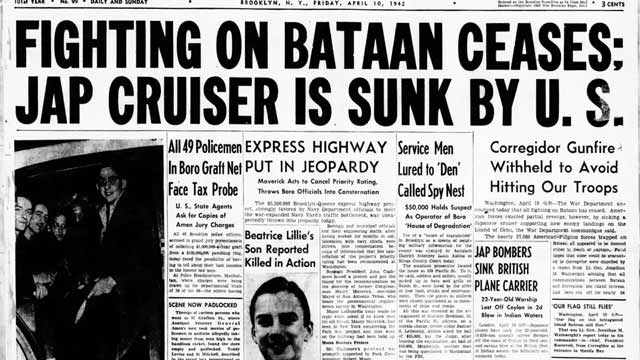Friday 10 April 1942:
 |
| The start of the Bataan Death March, 10 April 1942. This photo was taken from the Japanese by Filipinos during the Japanese occupation. US Marine Corps, via AP. |
Battle of the Pacific: One of the most searing events in US military history, the Bataan Death March, begins on 10 April 1942. Following the surrender on 9 April, the Japanese victors have massed the US and Filipino prisoners at Mariveles and Bagac. The march begins today in Mariveles, with Bagac following on 11 April. After assembling the prisoners in a rice paddy, the Japanese proceed to strip them of all valuables. Anyone found with Japanese war souvenirs or currency is shot. Then, the men are ordered to start marching. General Masaharu Homma has ordered that the prisoners be treated properly, but there is no supervision.
The first destination is the San Fernando railhead, where the men are to packed into railcars for a further one-hour trip followed by another march to Camp O'Donnell. The total distance to the prison camp is about 65 miles (110 km), though accounts vary. Everyone is forced to march regardless of their physical condition, and those who fall behind are shot. The Japanese act with increasing brutality during the march, beating prisoners, ripping out their gold teeth, and beheading some. Few refreshments of any kind are provided, and anyone who asks for water is shot out of hand. One of the worst incidents is when 300-400 Filipino prisoners are simply shot in the Pantingan River Massacre.
 |
| The Bataan Death March, 10 April 1942 (US Air Force). |
Overall, thousands of POWs perish during the Bataan Death March, with most of them being Filipino soldiers. Somewhere more than 500 US POWs perish. Conditions at Camp O'Donnell are horrendous, so men keep dying even after they complete the march. The Allied military commission later calls the entire affair a Japanese war crime. The US government keeps the Bataan Death March a secret until the eve of the liberation of the Philippines, when announcements are made beginning on 27 January 1944.
Meanwhile, there are still US holdouts at some islands in Manila Bay, commanded by the island fortress of Corregidor. Today, the crews of river gunboats USS Oahu and Mindanao disembark to man artillery at Fort Hughes. The Japanese continue their occupation of the Philippine Islands and land 12,000 troops on Cebu, where the US Navy scuttles tug Bacalod I. US Navy submarine Snapper evacuates a small number of people from Corregidor, while Japanese bombs sink US minesweeper Pinch near Corregidor (later salvaged and used as PB-103 by the Japanese). Other small craft, including motor torpedo boats Q-112, Q-113, Q-114, and Q-115, 2969-ton Philippine freighter Basilan, and 949-ton British freighter Venus, are scuttled nearby.
US Navy submarine Thresher torpedoes and sinks Japanese freighter 3039-ton Sado Maru about 6 miles (10 km) north of Oshima (near Yokohama) near the mouth of Tokyo Bay, Honshu.
Japanese fleet radio intelligence begins picking up the radio traffic being made between Pearl Harbor, Admiral "Bull" Halsey's Task Force 16, and the Doolittle Raid ships heading toward Japan. Halsey has not yet caught up with USS Hornet but will within a few days. The Japanese correctly deduce that the Americans may try to raid Japan. However, the Japanese calculate, based on typical carrier operations, that the US Navy will have to get within 300 miles of Japan before there is any risk to the homeland. Thus, they put the Twenty-Sixth Air Flotilla with its 69 land-based planes on alert but wait for an alert from a picket line of trawlers maintained in a six-hundred-mile line east of Japan. The Japanese take no other precautions.
Battle of the Indian Ocean: Admiral Chūichi Nagumo heads east away from Ceylon (Sri Lanka), ending the Indian Ocean Raid. He will head back to port via the Malacca Strait. As at Pearl Harbor, Nagumo is content with a clear victory rather than continue attacking in order to achieve a more decisive result. The Kido Butai strike force has sunk one aircraft carrier (HMS Hermes), two cruisers, 23 freighters totaling 112,312 tons, and caused extensive damage to Royal Navy infrastructure. All this was accomplished at a cost of 18 Japanese aircraft with damage to 31 others.
While proving a success in terms of results, the Indian Ocean Raid is a strategic failure. The British Eastern Fleet survives, though at a cost of several important ships and many lives. This was the main Japanese objective, and Nagumo failed to find and destroy this fleet. This reveals issues with Japanese air reconnaissance. The raid also reveals other problems with Japanese carrier operations, including leaky Japanese air cover around the carriers and difficulties in switching planes from one type of operation to another.
 |
| Wildcat of VF-6 on board USS Enterprise, which is in Admiral Halsey's Task Force 16 heading to join the Doolittle Raiders on the way to Japan. The crew is testing the machine guns. 10 April 1942 (US Navy). |
The British Admiralty is now reminded forcefully of its weakness, so it transfers the main Royal Navy base in the Indian Ocean all the way back to Kilindini, Kenya. It gives reinforcement of the Eastern Fleet the highest priority in the Royal Navy. However, the Japanese fail to exploit the successes of the Indian Ocean raid and never again return in force. This is a tremendous missed opportunity. After today, the Indian Ocean gradually returns to being a backwater in the sea war that is controlled by the Allies.
In Burma, the American Volunteer Group (AVG, or Flying Tigers) remains a thorn in the Japanese side. Pilots of the 2nd and 3rd Fighter Squadrons claim 4 downed Japanese aircraft over Loiwing in mid-afternoon.
 |
| Soviet infantry in Yukhnov, 10 April 1942. If you look carefully, you will see that the lead Soviet soldier is using a German MP 38. |
Eastern Front: It is the second day of General Kozlov's fourth offensive against the German line across the Parpach Narrows in the Crimea. The Luftwaffe has been heavily reinforced and German infantry reinforcements have new weapons (the 2.8 cm sPzB 41 light anti-tank gun) that prove efficient at stopping Soviet tanks. The Soviets are making small local gains but are taking heavy casualties. Kozlov allows the offensive to run for one more day after this.
Luftwaffe ace Hptm. Karl-Gottfried Nordmann, who received the Ritterkreuz at the hand of Adolf Hitler on 16 September 1941, is appointed Geschwaderkommodore of JG 51.
European Air Operations: RAF Bomber Command mounts a major raid against Essen. It sends 254 bombers (167 Wellingtons, 43 Hampdens, 18 Stirlings, 10 Manchesters, 8 Halifaxes, 8 Lancasters) over the Ruhr city, but the mission is frustrated by cloud cover. Bombing results are poor, with 12 houses destroyed, seven killed, and 30 injured. Ruhr Flak defenses contribute to downing 14 bombers (7 Wellingtons, 5 Hampdens, 1 Halifax, 1 Manchester).
The Essen raid is most notable for featuring the first use of an 8,000-lb pound. It is dropped by RAF No. 76 Squadron, but its impact is not noted by local authorities. There are minor operations by 40 aircraft to Le Havre (one Manchester lost), three Blenheim bombers to Holland, three minelaying bombers to Heligoland (one lost), and five leaflet flights to France. Overall, there are 16 aircraft lost in 305 sorties, a poor 5.2% loss rate.
Hptm. Wilhelm 'Wutz' Galland, Adolf Galland's brother, shoots down his fifth victim over Etaples to become an ace. It is a Spitfire Mk V of RAF No. 340 Squadron. Walther Dahl is appointed Staffelkapitaen of Ergänzungsgruppe./JG 3.
 |
| The Evening Star of 10 April 1942 highlights the supposed sinking of a Japanese cruiser and the sinking of HMS Hermes, but one must struggle to find any mention of events in Bataan. |
Battle of the Atlantic: U-654 (Oblt. Ludwig Forster), on its third patrol out of Brest, torpedoes and sinks 7,010-ton British freighter Empire Prairie about 490 miles northeast of Bermuda. The freighter breaks in two and sinks immediately. There are 49 deaths and no survivors.
U-203 (Kptlt. Rolf Mützelburg), on its sixth patrol out of Brest, torpedoes and sinks 8072-ton British tanker San Delfino east of Cape Hatteras. The U-boat has to fire several salvoes of torpedoes to sink the freighter, seven altogether, a fantastic number for one merchant target. There are 28 dead and 22 survivors.
U-552 (Kptlt. Erich Topp), on its eighth patrol out of St. Nazaire, torpedoes and sinks 6943-ton US freighter Tamaulipas about 18 miles northeast of Cape Lookout, North Carolina. The torpedo breaks the ship's back and the crew must abandon ship immediately without being able to send a distress signal. There are two dead and 35 survivors. This is U-552's final victory on this patrol, during which it sank seven ships of 45,731 tons.
U-85 (Oblt. Eberhard Greger), on its fourth patrol out of St. Nazaire, torpedoes and sinks 4904-ton Norwegian freighter Chr. Knudsen. All 33 men on the freighter perish. This is the final victory for U-85, which is sunk itself on 14 April 1942. U-85 finishes its career having sunk 15,060 tons of shipping.
Italian submarine Pietro Calvi torpedoes, shells, and sinks 2161-ton Norwegian freighter Balkis about 60 miles (110 km) north of Fortaleza, Brazil. There are seven deaths and 24 survivors.
 |
| Butch O'Hare in his Wildcat at Pearl Harbor, 10 April 1942. O'Hare already had earned the Medal of Honor, though it had not yet been awarded to him, and Chicago's O'Hare Airport is named after him. |
German raider Thor encounters 4840-ton British collier Kirkpool in the South Atlantic northeast of Tristan da Cunha and sinks it. There are 17 deaths, while the survivors are taken prisoner and ultimately taken to Japan.
British 3979-ton freighter Halifax catches fire and is written off near Halifax harbor. Canadian minesweeper finishes off the ship with gunfire due to its cargo full of explosives.
Fishing trawler FV Restless sinks in Massachusetts Bay for unknown reasons. No casualties.
US Navy stores ship USS Uranus runs aground at Akureyri, Iceland. It takes until 13 April to refloat the ship without much damage.
Soviet submarine K-421 hits a mine and sinks off North Cape, Norway.
Convoy QP 10 departs from the Kola Inlet heading for Iceland.
 |
| "A wounded British soldier being brought ashore from the Hospital ship LLANDOVERY CASTLE." 10 April 1942. © IWM A 8621. |
Battle of the Mediterranean: The Luftwaffe continues pounding Malta in the worst sustained air offensive of the war. Among the casualties today is the 392-ton Royal Navy patrol boat HMT Jade (T 56), sunk in Grand Harbour.
Over Malta, Lt. Herman Neuhoff of III./JG 53, acting Staffelkapitän of 6./JG 53, is shot down in error by his wingman, Leutnant Werner Schöw, who mistakes Neuhoff's Bf 109 for a Hurricane. Neuhoff becomes a POW with 40 victories in 452 missions. He survives the war and passes away in 2006. Schöw is KIA in June 1942.
Battle of the Black Sea: The Luftwaffe bombs and sinks 1326-ton Soviet destroyer escort Shaumyan near Gelendzhik in the Caucasus.
 |
| "A wounded prisoner being carried down the gangway from the Hospital ship LLANDOVERY CASTLE." April 10, 1942. © IWM A 8619. |
Anglo-Italian Relations: A prisoner exchange between the British and Italians concludes today when the hospital ship Llandovery Castle arrives back in Alexandria. The ship released wounded Italian captives at Smyrna and there was loaded with wounded British POWs.
US Military: The US Pacific Fleet is reorganized into new categories:
- battleships (Rear Admiral Walter S. Anderson)
- carriers (Vice Admiral William F. Halsey Jr.)
- cruisers (Rear Admiral Frank Jack Fletcher)
- destroyers (Rear Admiral Robert A. Theobald)
- service force (Vice Admiral William L. Calhoun)
- amphibious force (Vice Admiral Wilson Brown, Jr.)
- submarine force (Rear Admiral Thomas Withers)
- Patrol Wings (Rear Admiral John S. McCain).
The terms "Battle Force" and "Scouting Force" go out of use. Admiral McCain, incidentally, is the grandfather of future Senator John S. McCain III, currently six years old on 10 April 1942.
American Homefront: Hotel king Conrad Hilton marries socialite Zsa Zsa Gabor at the Santa Fe Hotel in New Mexico. Gabor, a former Miss Hungary, came to the United States in 1941 to join her actress sister Eva but has not yet entered show business herself. but did some singing in Europe. This is the second marriage for both.
John Wayne's "The Spoilers" is released to theaters. Also starring are Marlene Dietrich (who gets top billing), Randolph Scott, and Harry Carey. The film has a climactic four-minute fistfight between Wayne and Scott that mirrors their off-screen tensions (Scott demanded and got billing above Wayne).
 |
| John Wayne and Harry Carey in "The Spoilers," released on 10 April 1942. |
April 1942
April 1, 1942: Convoys Come to the USAApril 2, 1942: Doolittle Raiders Leave Port
April 3, 1942: Japanese Attack in Bataan
April 4, 1942: Luftwaffe Attacks Kronstadt
April 5, 1942: Japanese Easter Sunday Raid on Ceylon
April 6, 1942: Japanese Devastation In Bay of Bengal
April 7, 1942: Valletta, Malta, Destroyed
April 8, 1942: US Bataan Defenses Collapse
April 9, 1942: US Defeat in Bataan
April 10, 1942: The Bataan Death March
April 11, 1942: The Sea War Heats Up
April 12, 1942: Essen Raids Conclude Dismally
April 13, 1942: Convoy QP-10 Destruction
April 14, 1942: Demyansk Breakout Attempt
April 15, 1942: Sobibor Extermination Camp Opens
April 16, 1942: Oil Field Ablaze in Burma
April 17, 1942: The Disastrous Augsburg Raid
April 18, 1942: The Doolittle Raid bombs Japan
April 19, 1942: British in Burma Escape
April 20, 1942: The Operation Calendar Disaster
April 21, 1942: Germans Relieve Demyansk
2021


No comments:
Post a Comment